Hi, welcome to my 2024 *Find A Cure For ME/CFS* birthday fundraiser!
In the last 4 years of my birthday fundraisers, we have raised $185,000 for Ronald W. Davis, PhD's ME/CFS research which has helped him buy critical equipment that has moved the field of ME/CFS research forward.
Will you join me in raising funds for the Open Medicine Foundation for Ron's research this year? Watch this exclusive video with Ron about what he needs from us this year.
100% of your donation to this fundraiser will go to Ronald W. Davis's ME/CFS research at Stanford.

This fundraiser raises research funds that go to the Open Medicine Foundation (OMF). OMF funds many collaborative ME/CFS research centers around the world, but 100% of the funds from this fundraiser go exclusively to fund research at the ME/CFS Collaborative Research Center at Stanford, led by Ronald W, Davis, PhD. OMF is leading the world in ME/CFS research right now. They have a science board filled with award winning scientists from around the world including a Nobel Laureate. And the Chairman of the board is the famous Stanford scientist Ronald W. Davis, PhD who has spent his life tackling "unsolvable" problems through the invention of new technology and new approaches to thinking about these problems. He was named one of the world's greatest living inventors by The Atlantic.

This Year's 2024 Fundraiser
This year Ron needs more supplies to use with this equipment and this is equally important to the equipment itself or their research won’t be able to continue. Recently some key donors have had to pull their funding and this has left Ron’s lab without the funds to buy the supplies needed to run tests on this equipment. This includes things like the chemical reagents that allow them to run these experiments. This could include the plates that they use to hold the chemicals or the chemicals they use to put into those plates. It could also include necessities like glassware, gloves, pipette tips, etc., that keep the lab running.
In Ron’s own words from the video above, "We desperately need these supplies or we won't be able to start these big studies."
Let’s all come together and get Ron the supplies he needs to do these critical experiments that are honing in closer and closer to the root cause of ME/CFS!
Past fundraisers and information about ME/CFS...
2023 Fundraiser
Last year, 2023, Ron wanted to buy a Coulometric Array Detector and a specialized blood analyzer. However, the situation changed. They hired a new researcher who has a lot of experience in growing and establishing human cell culture, which is something they have never had but had long been needing. This enabled them to do a number of tests of the Itaconate Shunt hypothesis. She has also been able to modify human cells to test ideas about why BH4 is low in many patients. She has great lab skills so this was an exciting development, and Ron bought the following things with my 2023 fundraiser donations to enable her to accomplish this work.
Look at everything you all bought for Ron’s lab last year alone! They are using all of these instruments!
1. Quantitative PCR Instrument. This measures the concentration of DNA and/or RNA for a given gene or sequence in a sample. It is a key instrument to test the Itaconate Shunt hypothesis, because they need to know the concentration of a large number of these molecules involved in that pathway and associated pathways. This work is still in progress.
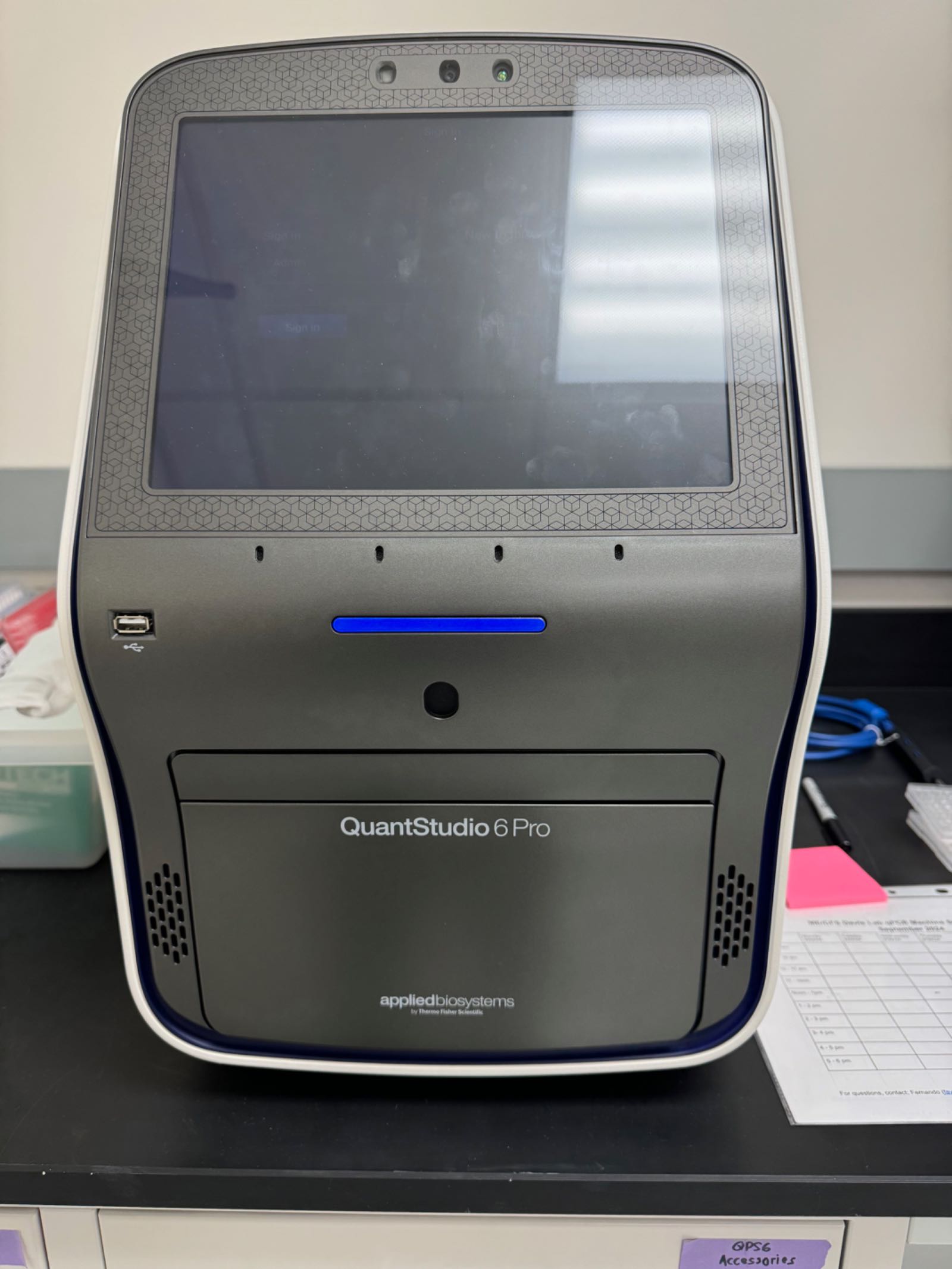
2. Cell culture incubator. This has allowed them to grow human cells and cultures derived from other labs or made from patient samples in the lab, which expedites their work so that they don’t have to go to other facilities. This incubator enables them to test different hypotheses about cause or susceptibility to ME/CFS. Using this instrument they have modified human cells and tested ideas as to why BH4 is low in some patients.
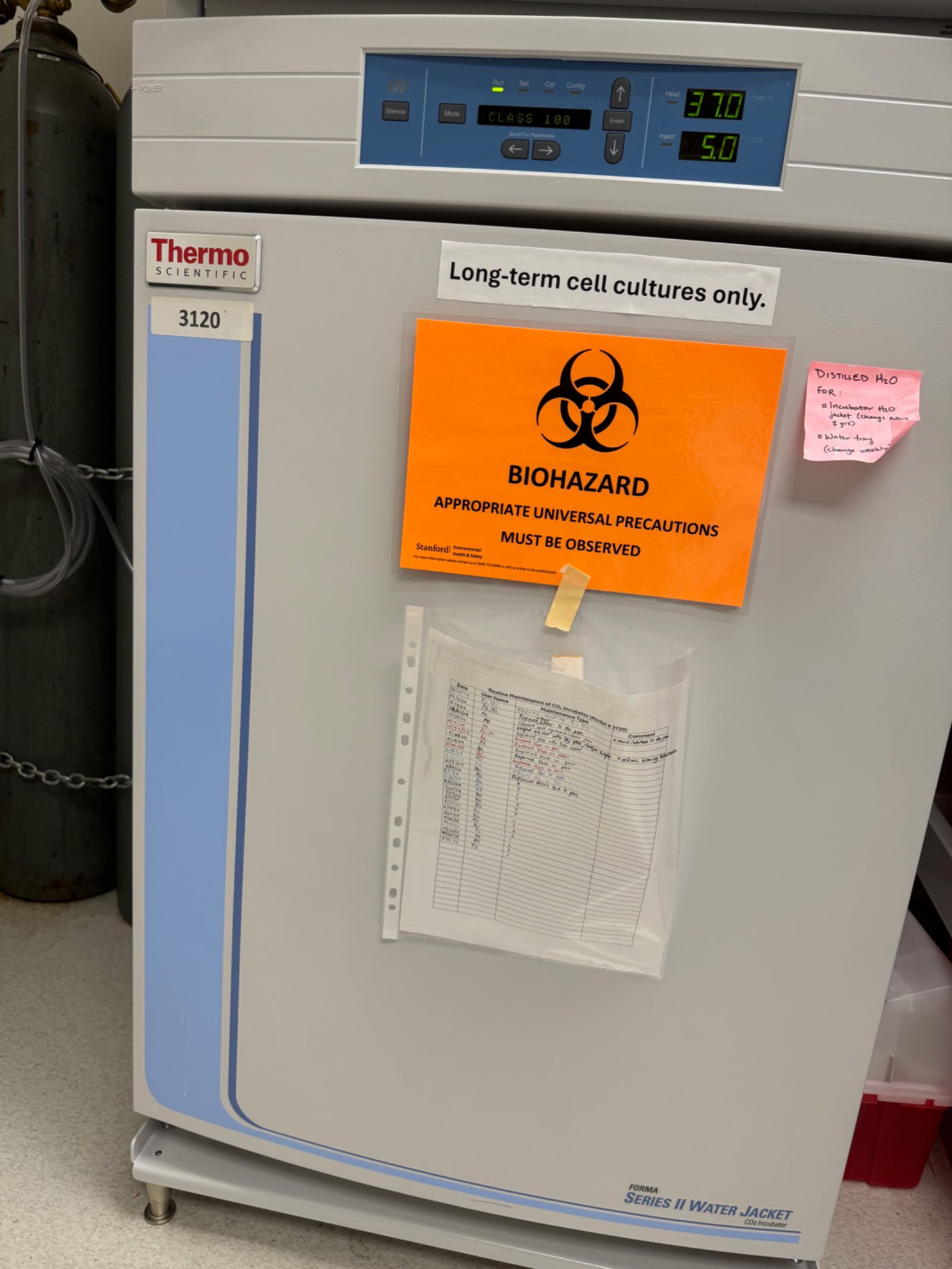
3. Cell culture hood that allows them to work with human cells in a sterile environment.This has been badly needed for several years. It is required to work with human cells. It has allowed them to expand the type of research they can do. They have been well equipped to do molecular analysis, (e.g., sequencing DNA, et al), but now they are able to evaluate the properties of patient cells, which requires growing them in cell culture. They are now able to evaluate the properties of cells , e.g., things that cause dysfunction like oxidative stress.
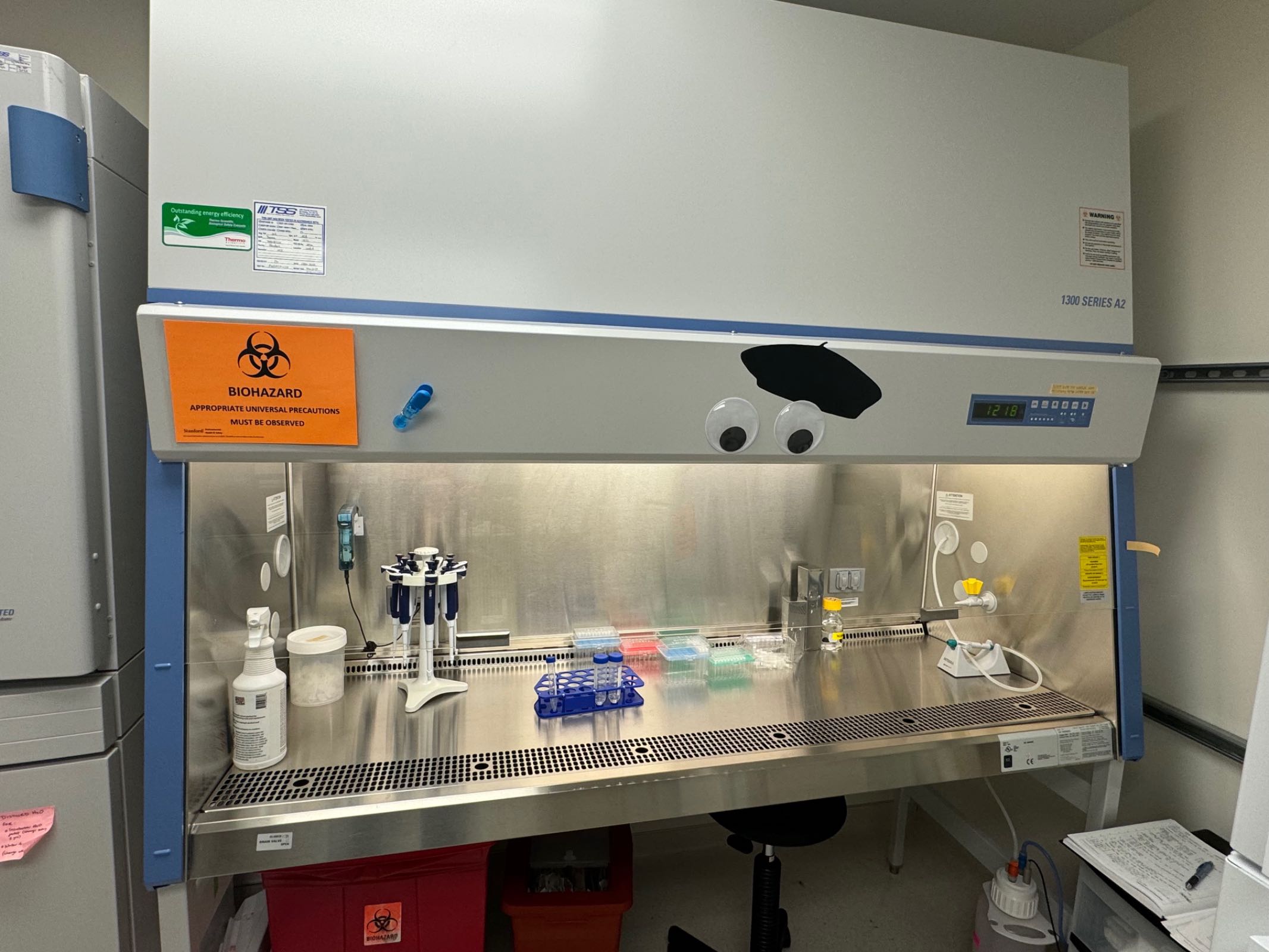
4. Water bath for doing incubation at the constant temperature necessary for enzymatic reactions or for growing microbial cultures.They use this in many experiments.
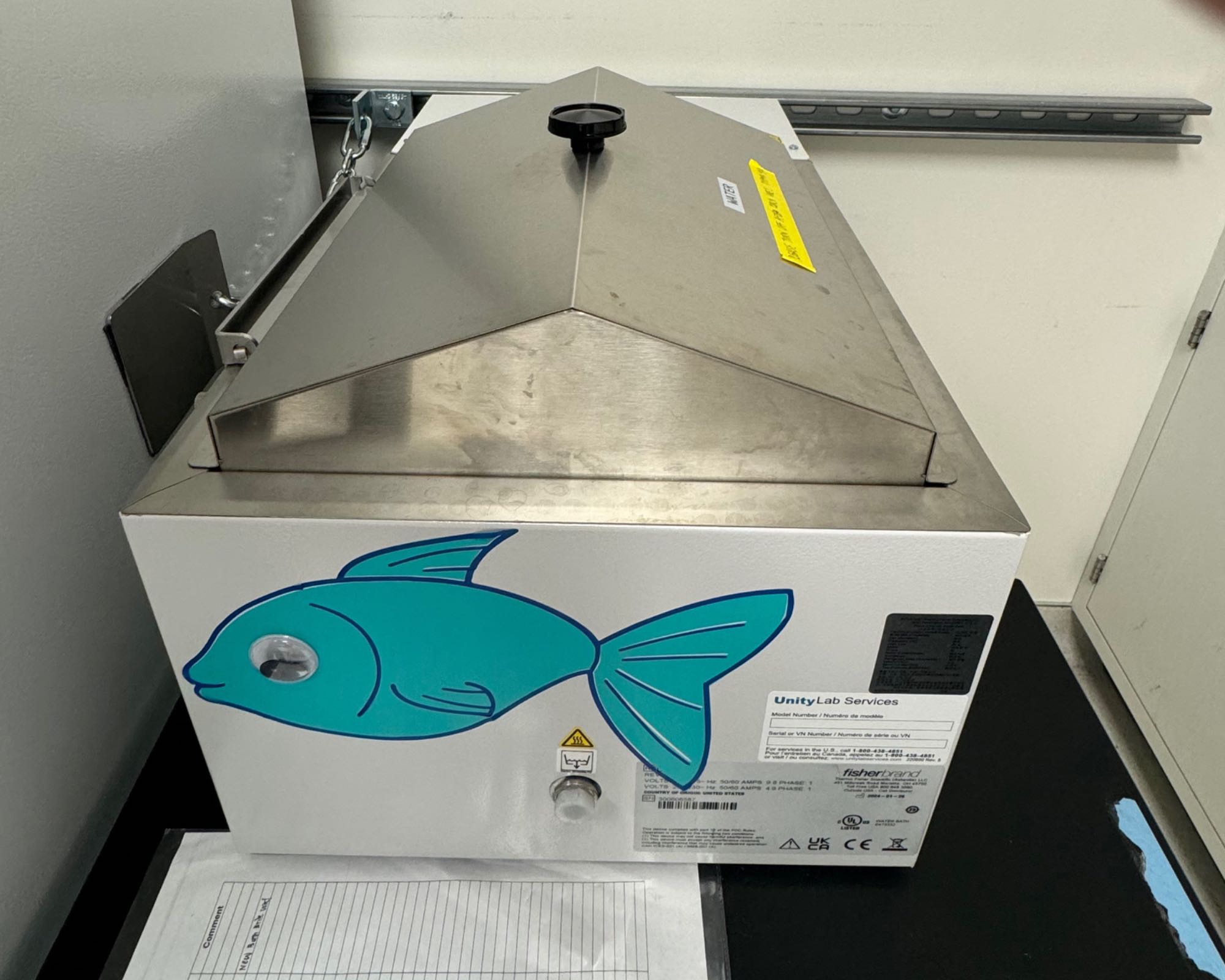
5. Light microscope and centrifuge for processing blood samples. This is a greatly improved group of instruments that replaced a very old set-up that had not been working well. It is absolutely critical for the work of all the scientists in the group. It's vital for getting reproducible sample processing.
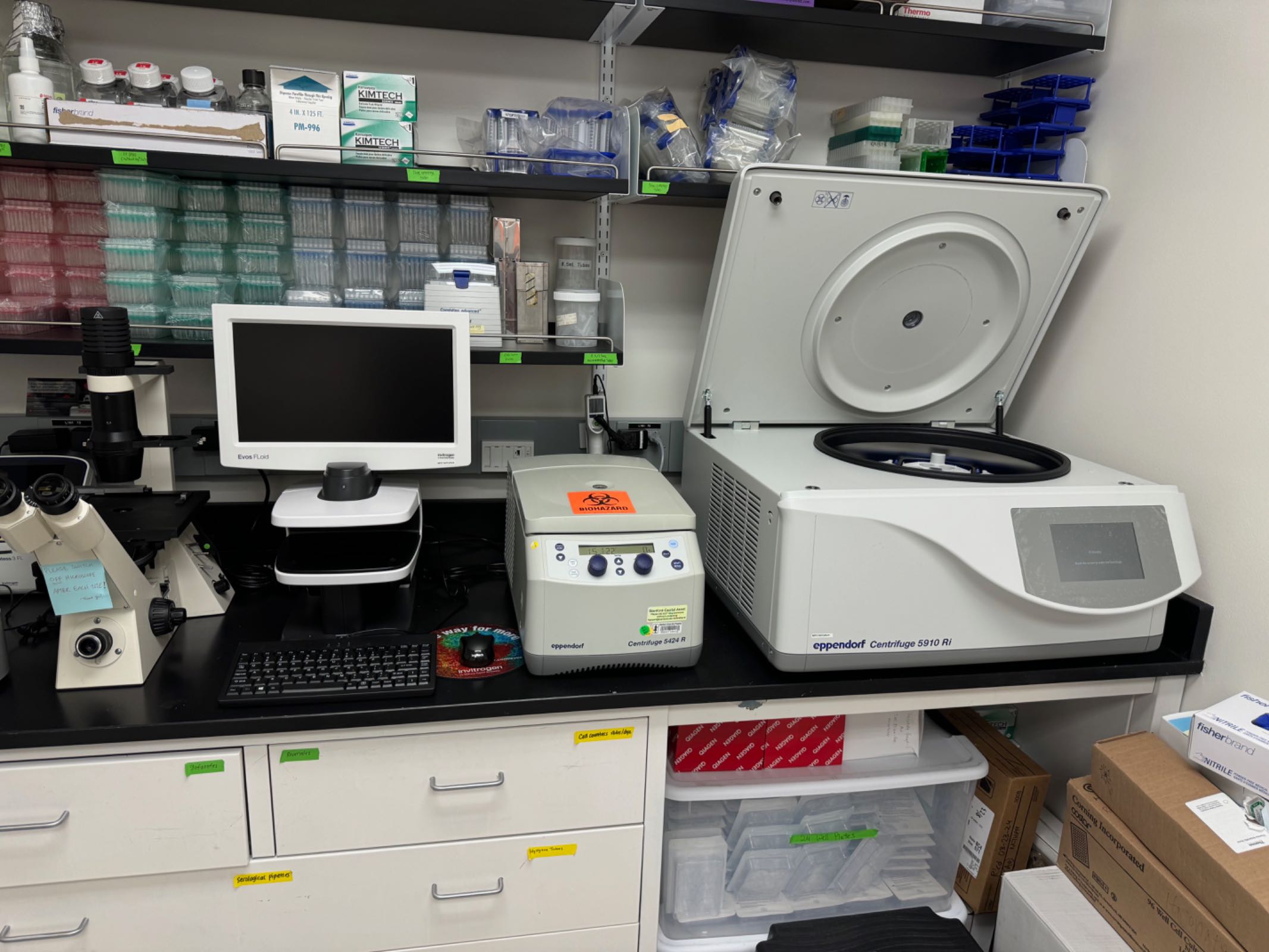
All the cell culture instruments are in one room, which makes it very efficient for conducting experiments, and Ron tells me that it’s a wonderful facility. It is really helping everyone in the lab to be able to do better experimentation, and the scientists are really grateful for my Birthday Fundraisers! They are very aware that patients are major funders of their work, and they are so appreciative.
2022 Fundraiser
In 2022, my birthday fundraiser enabled Ron’s lab to purchase a wide field fluorescent microscope to visualize cells in the blood to get a more accurate count and characterization of them.
The lab was very excited to get this because their old microscope was not working well. All of the projects in Ron’s lab are benefitting from this wonderful microscope, including the work on the itaconate shunt.
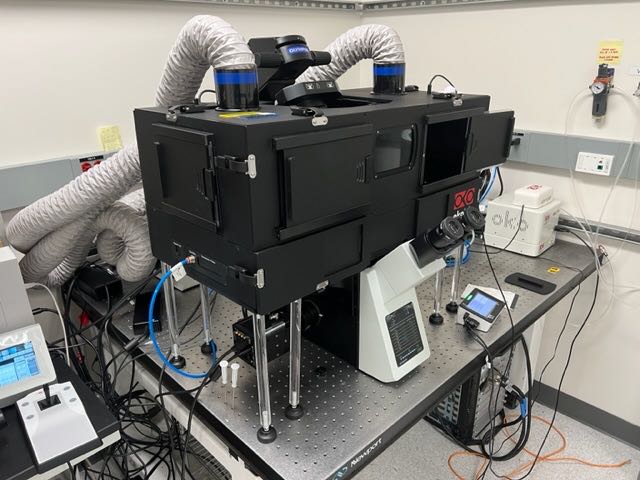
2021 Fundraiser
In 2021, my birthday fundraiser allowed Ron’s lab to purchase an electrochemical detector. Along with the HPLC, they are using it to measure BH4, folate, and other metabolites in the arginine pathway. No other laboratory has ever measured these things in MECFS patients. These molecules have been implicated in MECFS for a long time but they’re hard to measure and there’s no commercial assay so no one has studied them in ME/CFS patients. They are involved in the production of some of the hormones like dopamine and the production of nitric oxide, which is involved in blood flow. All these things may be involved in why the itaconate shunt does not turn off which could be the cause of ME/CFS.
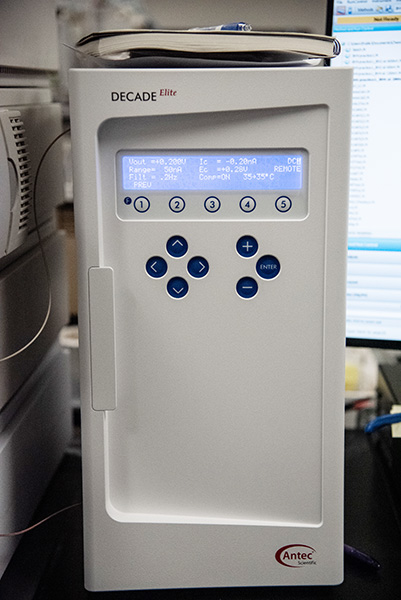
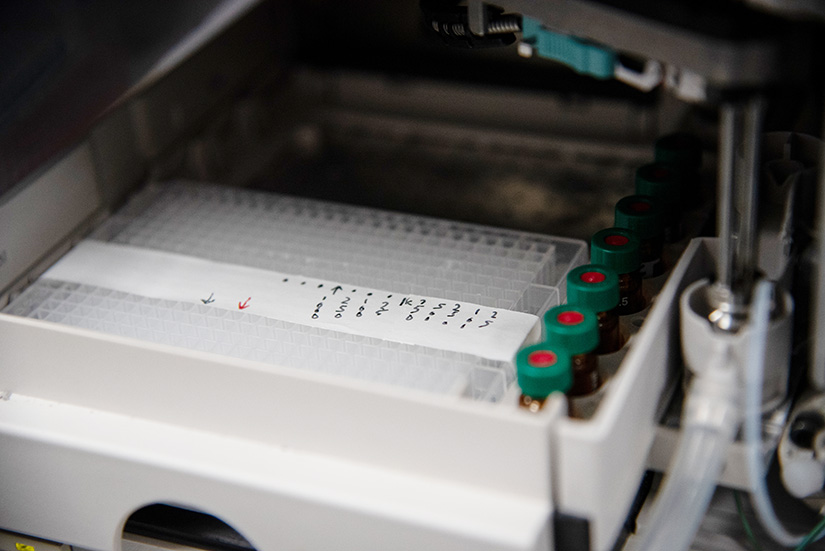
2020 Fundraiser
2020's fundraiser allowed Ron's lab to purchase a HIgh Pressure Liquid Chromatography Instrument (HPLC). Ron and everybody in the lab were really excited and grateful to get this new instrument because it has allowed them to do a large number of new experiments. They are now able to measure BH4 levels in patients’ blood, as well as lots of blood metabolites inexpensively and quickly. There is a plaque on this instrument honoring all of your donations that made the purchase possible. 

What Is ME/CFS?
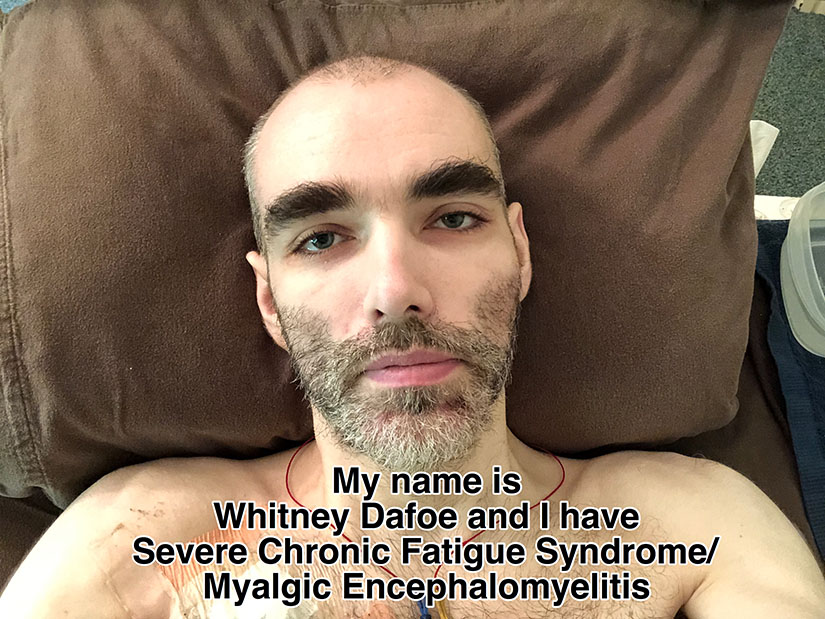
Chronic Fatigue Syndrome/Myalgic Encephalomyelitis (ME/CFS) is an extremely devastating illness that takes and takes and takes until there is nothing left but flesh and bone. I’ve lost my friends, my career, my hobbies, everything that brought meaning to my life and all sense of humanity.
ME/CFS is defined by what is called post exertional malaise. This means that ME/CFS patients have a reduced amount of energy compared to healthy people (vastly reduced in severe cases). But most importantly, when an ME/CFS patient pushes themselves over this reduced limit, they don't recover like healthy people after some rest. The illness gets worse for days, months, or often permanently. There are many more symptoms as well that vary from patient to patient including inability to think clearly, muscle and nerve pain that in severe cases causes pain throughout the body, unrefreshing or very poor sleep, and digestive problems likely caused by nervous system malfunction that controls the digestive process . When the illness is severe patients usually experience sensitivity to interaction with, or the simple company of other people, sensitivity to colors, sounds, light, noise and any other stimulus that forces the mind to use more energy than a severe ME/CFS patient has. Many severe ME/CFS patients live completely alone in dark rooms with eye masks and ear muffs and all text, colors and sounds around them reduced as much as possible. Some patients live like this for years or decades. And there are many more symptoms depending on the patient.
ME/CFS affects 4 million Americans (a number which is drastically rising with Long Covid which all experts agree is a form of ME/CFS, with an estimated 16 million more sufferers. Although Long Covid has received funding, Long Covid researchers have not consulted much with what is already known about ME/CFS, which is unconscionable).
Twenty-five percent of ME/CFS patients are estimated to be severely affected, being bedridden with little to no functioning. This population has been shown in studies to have the lowest functioning of any chronic illness, comparable to end-stage AIDS or end-stage renal failure shortly before death, except ME/CFS goes on for never ending decades. There is no known cause or cure.
Some patients slowly improve with time but commonly relapse back to where they were before or worse. However the majority of patients are sick, and in the worst cases, bed-bound for decades and very few recover. It is estimated that 4% of those with severe ME/CFS have any type of recovery. To die of this illness is atypical; To hover in an in-between state where one experiences a 'living death' for years or decades is quite typical.
For decades ME/CFS patients have faced unbelievable prejudice and their symptoms have been seen as psychosomatic or nothing but “laziness”. When people hear of this disease they often say, “I would love to lay around all day” to the shock of anyone who has experienced the real horrifying symptoms of the disease. Patients have been forced into psych wards all around the world for having “mental disorders” and subjected to extreme abuse that often leads to death. One patient was thrown into a swimming pool to force her to “get over it”. Unsurprisingly, she almost drowned and her illness worsened permanently. ME/CFS to this day faces extreme prejudice from the medical and scientific communities, almost all of which ignore it completely, and from society as a whole, most of whom know nothing about it and don’t usually do anything to help even when they do. Donations for research come almost entirely from patients, who are unable to work and are burdened with huge medical bills not covered by insurance since the disease is not recognized as “legitimate”.
However, research over the last decade has progressed and shown without question that ME/CFS is a real, severe, multi-systemic disease. Researchers have found unique abnormalities in the immune system (e.g., inactive NK cells, malfunctioning T cells, alterations in the innate immune system, a plethora of autoantibodies), in mitochondria (e.g., low energy (ATP) production, fragmentation), in the circulation system (e.g., low blood flow and blood volume, heart valve preload failure, lack of deformability of red blood cells, microclotting) , in the brain (e.g., inflammation, elevated temperature, high lactate, abnormal MRI and PET scans), in physical response to exertion (e.g., inability to perform similar to patients with other severe diseases a day or two after exercise, worsening symptoms after physical, cognitive or emotional exertion), in the G.I. system (e.g., altered, less diverse microbiome, low motility, presence of enterovirus, eating problems, pain), in sleep (e.g., non-refreshing sleep, disruptions of diurnal rhythm, other sleep disturbances), and autopsy findings that report dorsal root ganglionitis - a type of inflammation of the spinal cord.
Despite the ravages of ME/CFS, it is one of the least funded illnesses, again facing prejudice from NIH and all facets of government. Multiple Sclerosis is thought to be on average less severe in its impact on patients' quality of life, and affects half the number of people. Yet it receives 100 million dollars per year from the government for research while ME/CFS received 11 million last year. HIV receives 28 billion per year. With so little funding, there is no hope for the millions of people suffering from this illness.
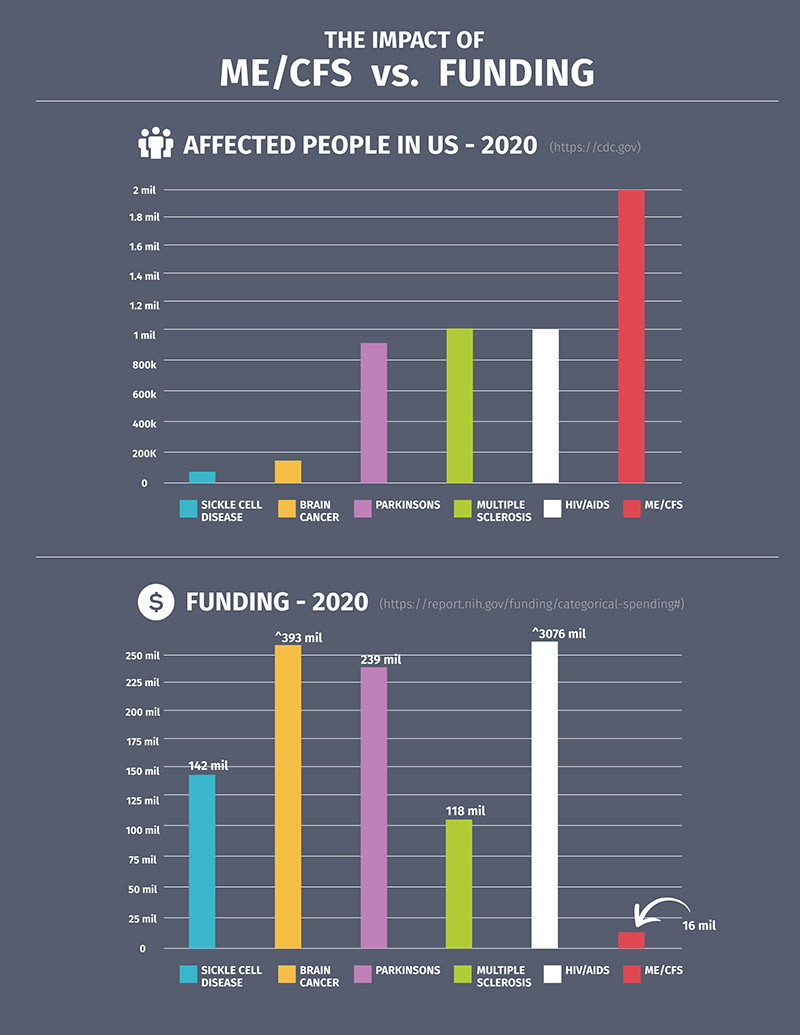
“My H.I.V. patients for the most part are healthy and hearty thanks to three decades of intense and excellent research and billions of dollars invested. Many of my C.F.S. patients, on the other hand, are terribly ill and unable to work or care for their families.
I split my clinical time between the two illnesses [AIDS and CFS], and I can tell you if I had to choose between the two illnesses (in 2009) I would rather have H.I.V. But C.F.S., which impacts a million [to 4 million] people in the United States alone, has had a small fraction of the research dollars directed towards it.” —Dr. Nancy Klimas, AIDS and CFS researcher and clinician, University of Miami
“[CFS patients] feel effectively the same every day as an AIDS patient feels two months before death; the only difference is that the symptoms can go on for never-ending decades.” —Prof. Mark Loveless, Head of the AIDS and ME/CFS Clinic at Oregon Health Sciences University
As a nation, we need to invest in ME/CFS. Ignoring it as we have been doing costs America an estimated 25 billion dollars per year in lost productivity and medical care. ME/CFS destroys millions of American lives, tears families apart and shatters dreams as people are isolated in bedrooms, nursing homes or left homeless with very little medical or societal understanding or support. All genders, races, ages, and socio-economic backgrounds are affected. Anyone could wind up sick and just drop off the map. And we will likely lose everything that person would have become or contributed to the world.
As a nation, we need to invest in ME/CFS.
If you are able, please consider making a donation to the Open Medicine Foundation (OMF) www.omf.ngo They are leading the world in funding ME/CFS research right now. They have a science board packed with award winning scientists from around the world including Nobel Laureates. And this board is directed by the famous Stanford scientist Ronald W Davis, PhD, who has spent his life tackling "unsolvable" problems through the invention of new technology and new approaches to thinking about these problems. He has won many awards for his work including being named one of the greatest living inventors by The Atlantic. But Ron doesn't have the funding he needs to pursue all of his ideas, to develop experiments that are as complete and thorough as he would like, and to hire a bigger group of multi-disciplinary experts to pursue treatments and a cure as fast as possible.
Please consider giving whatever you can today. You have the power to help millions of profoundly suffering people all around the world just waiting to get their lives and loves back. Thank you.
-Whitney Dafoe, severe ME/CFS patient
100% of your donation to this fundraiser will go to Ronald W. Davis's research.
My Story
My name is Whitney Dafoe and I have severe Chronic Fatigue Syndrome/Myalgic Encephalomyelitis (ME/CFS). I have had symptoms for 18 years but have slowly gotten worse because of a lack of beneficial treatments.

For the last 10 years since 2013 I have been completely bedridden and unable to speak or communicate in any way. I can’t eat even a tiny crumb of food or drink a drop of water due to a paralyzed stomach (severe gastroparesis). I am fed through a tube that goes directly into my stomach (called a J—Tube) which feels like being injected with cement everyday. All fluids go through a permanent tube inserted into my chest (PICC line).

From 2013 to 2020 I coudn't do anything while lying in bed. I wasn't able to use my phone, computer or camera or communicate in any way. I was unable to work on anything or do any of the things that used to bring meaning to my life. Even when I was alone in my room minor movement or activity was difficult for me and any extra stimulation that would bring joy or meaning to a healthy person hurt me.

I couldn't think clearly due to blood circulation problems to my brain. So I couldn't daydream much. Most of the time I lived in a thoughtless, feelingless void that was more horrific than anything I ever could have imagined.
When caregivers came into my room to bring me basic necessities, I had to hold completely still, with earmuffs on and a towel over my eyes to isolate myself from them as much as possible. Moving even a muscle with them in the room would make my health worse.
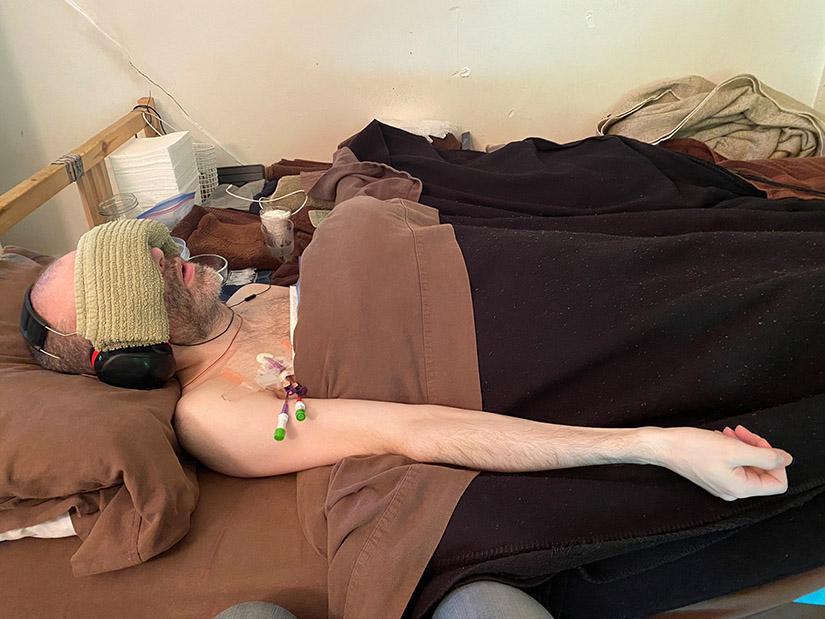
i have recently seen some minor improement from a new experimental drug that I started in 2020. it is not a cure, but i improved enough to move in bed, use a phone and computer, type, and work on some simple low energy hobbies in bed. It also allowed me to write things like this to communicate what severe ME/CFS is like. Though even writing this is a strain on me and i have to pace myself and be careful or I could get worse.
I am alone in bed all the time except for brief moments when caregivers come into my room to do basic tasks that keep me alive. If a caregiver makes a tiny mistake deviating from the everyday routine it can be too much mental stimulation causing me to use more energy in my brain than I’m capable of and the consequences can be devastating to my health making me permanently worse.
I also have to keep to a daily routine myself because otherwise it’s too difficult to avoid accidentally doing too much and exceeding my energy limits which makes me worse. If I ever went way above my energy limits I could die. So everyday is the same for me with almost no spontinaeitiy or sense of life or freedom.
I cannot work towards any of my dreams. They are all on hold as my life is held captive by ME/CFS. This experience is heartbreaking as it goes on for yet another year. The only thing that holds hope for me getting my life back is research by Ronald W. Davis.


